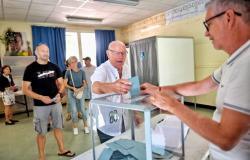The technology is as old as the 19th century. Electromagnetic induction involves passing an electric current through a coil which creates a magnetic field strong enough to cause a new electric current to appear in another coil located at a distance. “Electric toothbrushes and some phone chargers work like this.recalls Joseph Beretta, honorary president of Avere-France, the professional association for the development of electric mobility. Powering vehicles while they are moving is a challenge of another magnitude, but one that will facilitate the penetration of electric models.”.
This is the whole point of the European INCIT-EV program, endowed with 15 million euros, to plow this difficult furrow which has undergone some experiments since the 1990s in the United States and is currently being tested in Asia. Researchers from the European program met on June 26 in Paris to draw up an initial assessment of the seven current experiments.
Started in 2020, INCIT-EV is a program funded by the European Commission to bring out demonstrators of new electric vehicle charging technologies that would facilitate their use. This involves doing better than slow charging at home or in the car park and rapid charging at road and motorway terminals, by removing the electricity supply cable. The project brings together around thirty public and private partners from five European countries (in addition to France, Estonia, Spain, Italy and the Netherlands).
Since it involves automobile construction, road infrastructure, electricity distribution and environmental research, for example, for France we find partners as diverse as the manufacturers Stellantis and Renault, the electricity distributor Enedis, the public works company Colas and the Gustave Eiffel University with the support of the cities of Paris and Versailles which provide the setting.
Cars powered directly by the local electricity network
In Tallinn, super-fast charging stations were studied, in Amsterdam, bidirectional techniques that allow cars to store electricity, in Turin, charging centers in car parks, in Zaragoza, static charging by induction. Paris and Versailles are therefore home to the most disruptive experiences: charging while driving.
Researchers at the French Vedecom Institute dedicated to research on the energy transition of mobility designed the coils to be inserted into the bitumen and imagined the architecture of their alternating current supply directly from the Enedis distribution network and the converters to supply the coils with direct current suitable for consumption by the vehicle batteries. Three prototypes were equipped with coils, two individual cars, the Renault ZOE and the Stellantis DS3 and a utility van requiring more power.
The operating principle of induction charging. The alternating current distributed by Enedis passes through converters which supply the coils with direct current, which communicate with the coil present in the vehicle. Copyright Vedecom. Click on the image to enlarge
Rue Floréal is thus equipped with thirty 102-centimeter-long coils, each connected to its converter inserted under the sidewalk, the whole being controlled by a single power station connected to the network. The system can power the two cars, which are limited to 30 kW of power since the authorized speed in town is 30 km/h, and the van to 90 kW because it is heavier.
In Versailles, the configuration is completely different. The road is equipped with 8 coils 10 meters long, covering a distance of 80 meters, allowing for a greater recharge and therefore a greater speed and a longer distance traveled. The two cars therefore see their power increase to 90 kW. For several months now and for several more months, the three prototypes will regularly use the two laboratory tracks to test the operation of the whole thing.Therefore, the coils only operate when the vehicle passes and it is therefore necessary to check that the coils no longer emit a magnetic field once it has passed, continues Joseph Bataille. This precision electronics will ensure that there are no electromagnetic field emissions into the environment.”
Accelerating the transition of transport to electric already underway
The tests do not only focus on the dialogue between the road and the car and its stability over time. The researchers also want to know how the coils behave in a difficult environment. The roads are exposed to both intense solar radiation, which sometimes melts the surface, and extreme cold at night. The equipment will therefore have to withstand these extreme conditions.
Because the members of INCIT-EV are convinced: they have a solution that should completely free up the use of electric cars, which are already on the rise since, according to a survey by the European Observatory of Alternative Fuels, 57% of European drivers of thermal cars (46% of French people) are now considering switching to electric. Removing the worry of recharging could therefore further accelerate the trend.But there are other advantages: inductive charging will reduce the number of batteries needed for each vehicle and therefore lower their weight, consumption and price while also reducing the need for rare metals and lithium,” boast Joseph Beretta.
We are not quite there yet, but the experience of Versailles and Paris will make it possible to define the standards for coils and converters in order to impose the same equipment on all roads in Europe. In any case, the project is devoting 8.87 million euros to this. And there is also the question of price, because the service will have to be paid for, so the experience will allow us to develop computer systems so that the road recognizes the car that passes over it and sends the bill to the right person. » also notes Joseph Beretta.
Start with static charging
Answering these practical questions seems premature. It is not tomorrow that the entire European road network will be equipped with induction coils.But the first step will be static,” corrects Joseph Beretta. The three prototypes tested in the Paris region therefore regularly travel (by truck) to Zaragoza to test induction charging in parking lots. So, initially, induction could replace the charging stations that we see popping up everywhere.
Corporate fleets could thus serve as pioneers. Another configuration that interests researchers is the lines of taxis waiting for customers at airports and train stations.These vehicles remain in line for a long time, moving forward little by little, states Joseph Beretta. We can therefore equip the stations with coils which will recharge the electric taxis while they wait.”.
INCIT-EV then considers a step-by-step development with initial projects targeted on the axes where heavy goods vehicles are the most numerous to help with the electrification of goods transport, then spread over time from the busiest roads or by equipping those that need to change their covering. In theory, nothing impossible…






